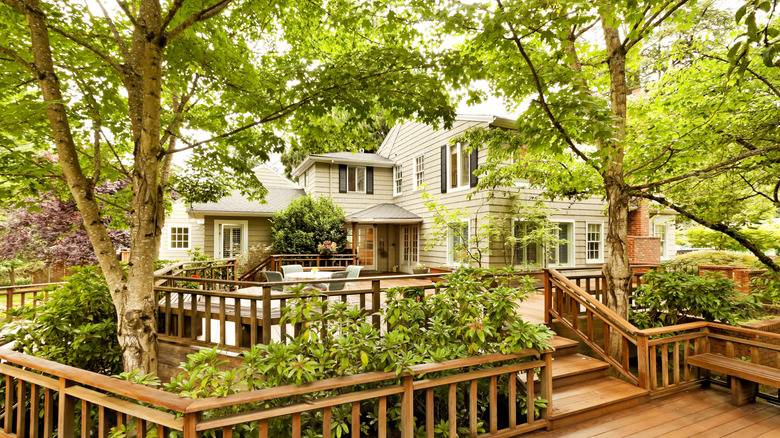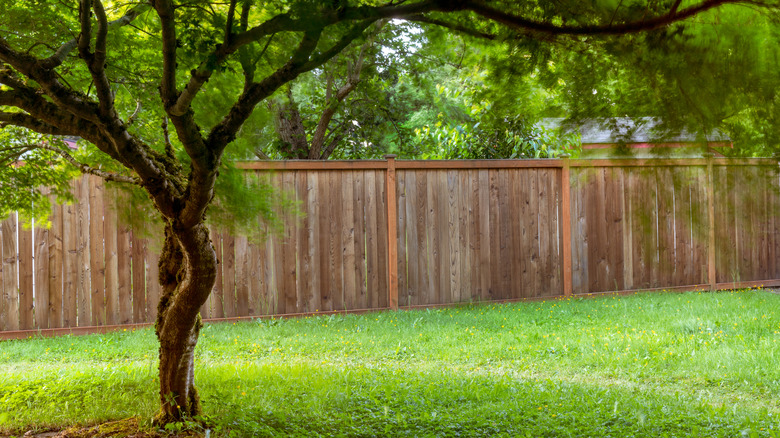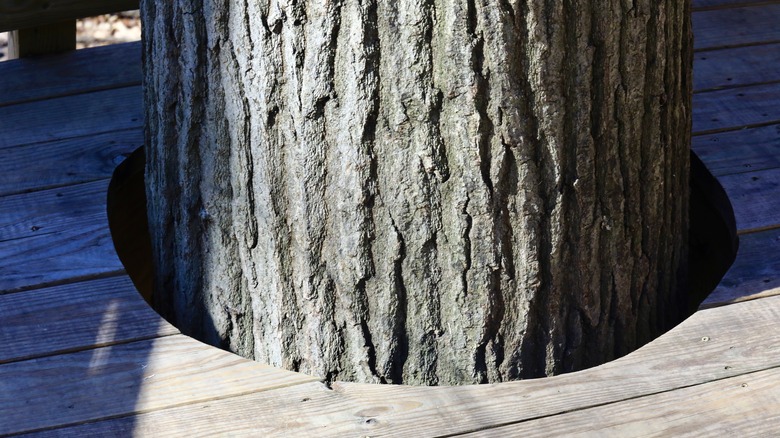Don't Let That Tree In Your Backyard Stop You From Building A Deck. Here's What To Do
Is a backyard tree thwarting your plans to build a deck? Are you thinking about cutting it to make room for this outdoor improvement? Doing so would make construction easier, sure, but know this: many jurisdictions require you to get a permit to remove a tree, even if it's on your private property. The good news is that you don't have to give up on your dream of having a deck in the backyard, and nor do you need to cut down the tree. Trees and decks can coexist harmoniously in close proximity — that is, if you plan the deck right and build it around the trunk. Also, thanks to a tree's canopy, your deck can get plenty of natural shade, so you can entertain outdoors even on sunny days. Trees also keep air clean, slow soil erosion, and attract wildlife. If you want to add a wood deck to your home before selling, the tree can boost your resale value as well.
But building a tree-encompassing deck is more involved than making a cut-out in the deck boards. First, you need to ensure that the tree is a good outdoor companion; as you'll see below, in some cases, it may be best to locate the deck away from its canopy. Also, you will need to ascertain that the tree is healthy enough to withstand deck construction. Finally, the deck design must leave the tree sufficient room to grow and not interfere with its roots.
Find out if your tree can accommodate a deck around it
There are some factors to consider when establishing the tree's ability to complement the deck. To begin, some trees have certain undesirable qualities you may not be aware of until they become a permanent fixture on your deck. For example, pine trees naturally drip sap. You may notice particularly large amounts of the gooey liquid ending up on your deck in the spring and summer. Dripping sap may also be a natural occurrence with maples around this time of year. Other species, such as oak, elm, and ash, may be prone to insect infestations that result in the release of honeydew (the insects' excrement), which drips down from the trees' leaves and resembles sap. If the tree in question can produce these liquids, it's best to situate the deck elsewhere. Otherwise, you'll have to clean up the tree sap whenever it drips.
Sap isn't the only annoyance a deck-enclosed tree can subject you to. For instance, the catalpa tree can litter your deck with tiny seed pods. Meanwhile, horse chestnut trees bear large fruit that can be hazardous when they drop down from the branch. Even if the tree in your yard isn't associated with any known nuisance, you'll have to make sure that it's healthy enough to withstand the deck construction process without problems. Hiring an arborist for a consultation is a wise step before you commit to designing and building the deck.
Design a deck that promotes the tree's health and growth
While the arborist is assessing your tree's health, ask them what dimensions the trunk will grow to at maturity. Getting this information is an important first step in preparing your DIY deck plans, as you'll find out how much clearance you must leave. Also, decks generally need footings (or other compliant support structures, depending on your jurisdiction). That's why you should ask the arborist about the possible implications of excavation and footing construction on the tree's roots. Get them to explain what distance from the tree is safe enough for this type of work to take place. At this phase, it's a great idea to liaise with a decking contractor who can provide you with structural drawings that show footing locations — and their proximity to the roots. You'll need these drawings anyway to get a deck construction permit.
Drainage is another factor to account for when you're designing the deck. If the deck boards slope toward the hole with the tree, there will be far too much water pouring toward the base of the tree any time it rains. This excess water can cause root rot. Conversely, building the deck in such a way that no rainwater gets to the tree will starve its roots of moisture. Ensure the decking contractor designs the deck so that the tree gets as much rainwater as it would naturally. With these crucial considerations accounted for, apply for the permit and start building!


